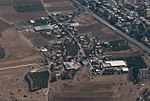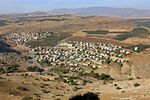Sieges of Tiberias (1742–1743)
The sieges of Tiberias occurred in late 1742 and the summer of 1743 when the Ottoman governor of Damascus, Sulayman Pasha al-Azm, twice attempted and failed to eliminate the increasingly powerful, Tiberias-based multazim (tax farmer), Zahir al-Umar, and destroy his fortifications. Sulayman Pasha operated under orders from the imperial government to execute Zahir, and was militarily backed by the governors of Sidon and Tripoli, as well as the district governors of Nablus, Jerusalem, Gaza, and Bedouin levies. Zahir and his family, the Banu Zaydan, controlled and fortified several places in the Galilee, with Zahir based in Tiberias, and his brother, Sa'd al-Umar, in nearby Deir Hanna. In 1737 and 1738, Zahir had intensified his raids, incursions, and operations to areas under the jurisdiction of Damascus, prompting the imperial orders to eliminate him and his local allies. The first siege of Tiberias lasted for nearly three months, with Sulayman Pasha unable to breach the fortifications and forced to withdraw to lead the Hajj caravan to Mecca. Zahir strengthened Tiberias, while unsuccessfully lobbying the imperial government through the French merchants of Acre and the Jewish community in Tiberias, who attempted to leverage their contacts in the imperial capital, Constantinople. Shortly after his return to Damascus, Sulayman Pasha renewed the campaign in July 1743, with more troops and weapons. He attempted to reduce Deir Hanna, which supplied Tiberias with arms and provisions, but died suddenly in his camp. Zahir soon after reached a détente with Sulayman Pasha's successor, As'ad Pasha al-Azm. The next fourteen years were generally free of hostilities with Damascus, which enabled Zahir to focus on occupying the port of Acre in the 1740s.
Excerpt from the Wikipedia article Sieges of Tiberias (1742–1743) (License: CC BY-SA 3.0, Authors).Sieges of Tiberias (1742–1743)
Tamar, Galil Tachton Regional Council
Geographical coordinates (GPS) Address Nearby Places Show on map
Geographical coordinates (GPS)
| Latitude | Longitude |
|---|---|
| N 32.8 ° | E 35.5 ° |
Address
תמר
Tamar
1427943 Galil Tachton Regional Council
North District, Israel
Open on Google Maps









